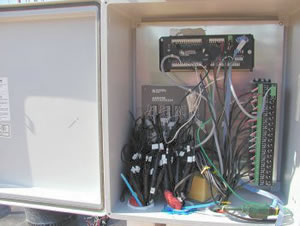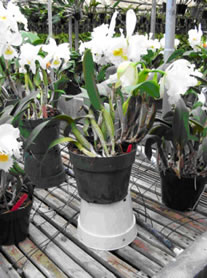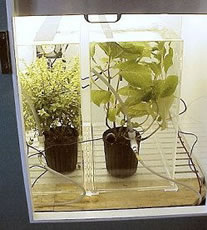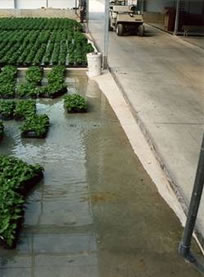
Lighting
Supplementary lighting can be beneficial or even necessary for the production of high quality plants. Many greenhouse crops benefit from supplemental light in the winter months when there is relatively little sunlight. For production of horticultural crops in plant factories, supplemental light is critical, since crops are grown inside buildings, where they may not receive any sunlight.
Lighting Research Sponsors
Our lighting research is supported through federal grants, lighting companies, and industry.
Crop imaging
Crops can undergo a wide variety of stresses throughout their production cycle. Detection of such stresses is still heavily dependent on scouting. However, it is extremely difficult to detect stresses very early, before significant damage has occurred. To help CEA growers detect stresses as early as possible, and allow for mitigating action, we are testing various imaging approaches (chlorophyll fluorescence, multi-spectral). Such imaging holds great promise for fully-automated early stress detection.

Our imaging research is supported by:
Spectral effects on photosynthesis
For almost a century the effects of light spectrum on photosynthesis was studied using narrow-band light sources. Although this has resulted in great insights into photosynthesis. It also has resulted in persistent misconceptions. We have disproven two of those misconceptions. We have shown that:
- Far-red photons (700- 750 nm) have similar photosynthetic efficiency as PAR (400 – 700 nm) (in contrast to what typical photosynthetic action spectra suggest (figure on the right)
- Plants use green light quite efficiently, especially at high light intensities

Past Projects
Irrigation Controllers
The Horticultural Physiology Lab has done much research on drought stress and plant responses to different irrigation regimes. To do this research the way we wanted to, we had to develop our own irrigation control systems, giving us the level of control over irrigation that we felt was necessary. The principle behind these irrigation control systems is simple: we use soil moisture sensors to measure the volumetric water content of the soil or substrate and if the water content is below a particular threshold, we briefly open an irrigation valve to irrigate that particular plot.


Water Requirements of Greenhouse and Nursery Crops
There is increasing pressure on the greenhouse and nursery industries to use water more efficiently. For many years, it has been common practice to water until water runs out of the bottom of the pots, and up to 50% of all the water may be lost this way. By watering according to the needs of the plants, this can be prevented.
Irrigation Control for greenhouse and nursery crops
Water is becoming an increasingly scarce resource and there is increasing pressure on the greenhouse industry to use water more efficiently. We are working on using soil moisture sensors to determine when irrigation is needed and how much water needs to be applied.

Whole plant CO2 exchange.
By measuring the carbon exchange rate of whole plants continuously, plant growth can be determined very accurately and non-destructively.This technique is currently being used to determine the drought tolerance of bedding plants. Other research areas include the estimation of growth respiration and maintenance respiration throughout plant development, and light, temperature, nutrition, and atmospheric CO2 concentration effects on plant growth and carbon use efficiency. Whole plant CO2 exchange measurements have also been used to determine phytotoxic effects of pesticides, and to quantify the effects of azalea lace bugs on the growth of azalea plants.
The use of recycling subirrigation systems in greenhouses.
The goal of this research was to develop simple and reliable guidelines to enable growers to manage recirculating irrigation systems. This includes the development of guidelines for pH and electrical conductivity of the growing medium.


Fertilization in Greenhouses: an Introduction
Nutritional problems are among the most common problems in greenhouses and can lead to serious economic losses.








